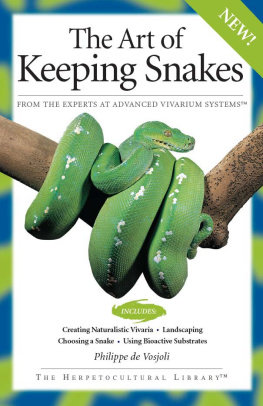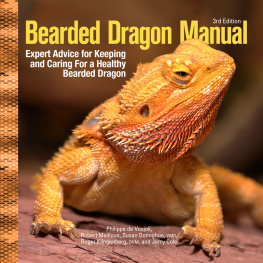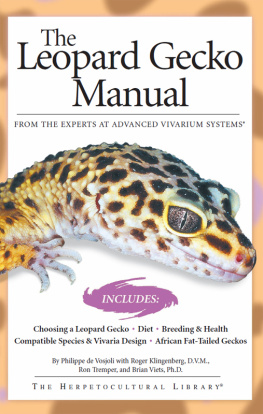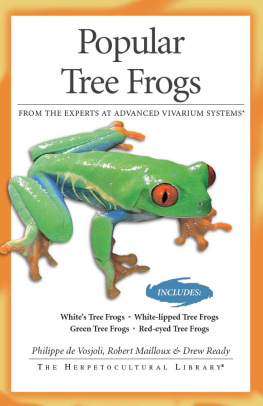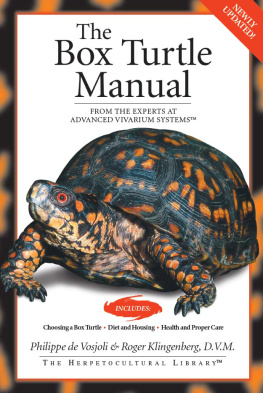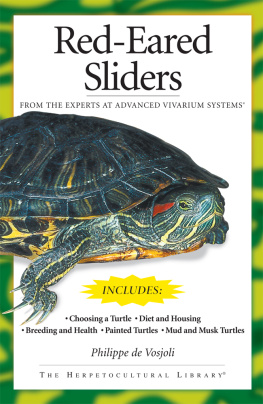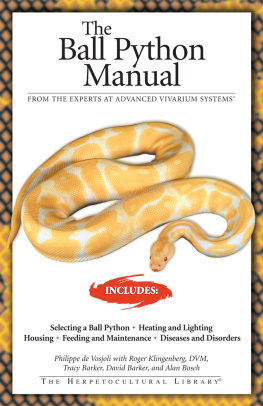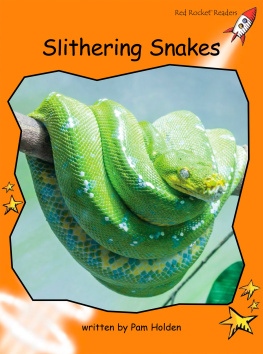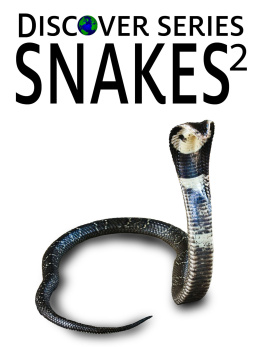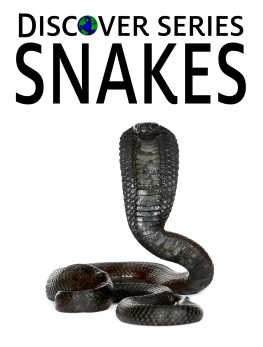The author wishes to thank the many friends who came to the rescue and provided animals and/or photos for this project. Special thanks go to Bill Love and David Northcott for their outstanding photos and to Kristin Mehus-Roe of I-5 Publishing, LLC, for the careful final editing that made this book possible.
The author would also like to thank his good friends, Susan Donoghue, V.M.D., for editorial guidance and general brainstorming, and Roger Klingenberg D.V.M for his support through the authors many writing and herp ventures.
Karla Austin, business operations manager
Kristin Mehus-Roe, editor
Erin Kuechenmeister, production editor
Nick Clemente, special consultant
Designed by Michael Vincent Capozzi
All photos by Philippe de Vosjoli unless otherwise noted
Rachel Rice, indexer
Cover photography by David Northcott
The photographs in this book are courtesy of: Bill Love, pp. 9, 12, 112 both; 119, 121, 125, 126, 127, 128, 130, 131 both, 132 both, 156 both, 167, 168, 172 bottom, 175, 177, 182, 186, 191, 198, 200 both, 203, 205 bottom, 206, 210, 211, 214, 215; David Northcott, pp. 148, 149, 150, 153, 155, 158, 159, 163, 164, 165, 166, 170, 172 top, 179, 183 both, 187, 192, 193, 195, 196, 204, 205 top, 209, 213.
Copyright 2004 by Advanced Vivarium Systems, Inc.,
All rights reserved. No part of this book may be reproduced, stored in a retrieval system, or transmitted in any form or by any means, electronic, mechanical, photocopying, recording, or otherwise, without the prior written permission of Advanced Vivarium Systems, except for the inclusion of brief quotations in an acknowledged review.
LCCN: 96-183295
ISBN: 1-882770-63-3
eISBN: 978-1-62008-028-3

An Imprint of I-5 Press
A Division of I-5 Publishing, LLC
3 Burroughs
Irvine, CA 92618
www.facebook.com/i5press
www.i5publishing.com
(877) 4-AVS-BOOK
We want to hear from you. What books would you like to see in the future? Please feel free to write us with any comments on our AVS books.
Printed in Singapore
10 9 8 7 6 5 4 3 2
CONTENTS
Part I:
A New Way to Keep Snakes
CHAPTER 1:
WHAT IS THE ART OF KEEPING SNAKES?
D uring the last twenty-five years, the popularity of keeping snakes has surged in North America, Europe, and, more recently, Asia. More than fifty kinds of snakes are now regularly bred in captivity and over one hundred species are now regularly available through pet stores, specialized dealers, private hobbyists, and the many herp shows and events that have sprung up in recent years.
For those of us who have worked with snakes since the 1960s, the sudden rise in popularity was not shocking. It was only a matter of time before the secret got out: snakes are among the most beautiful and fascinating of all the vertebrates. Once people overcome their bias and superstitions, they quickly recognize the aesthetics of snake pattern, color, scalation, grace of movement, and behavior.
Originally, as with other animal-related hobbies, the herpetoculture of snakes had to overcome a major hurdle: determining the basic methods for keeping snakes alive for extended periods of time and successfully propagating them over several generations. Indeed, no animal-based hobby can survive or progress to the next level until this primary issue is overcome. It is only in recent years, after firmly establishing a wide variety of snake species in captivity, that American reptile keepers have followed in the footsteps of European hobbyists and begun to create naturalistic vivaria for displaying snakes.
The purpose of this book is to introduce the reader to the cutting edge of naturalistic vivaria methods. It is the combination of the intrinsic beauty of snakes and the art of designing eye-catching naturalistic displays that hobbyists call the art of keeping snakes.
I am often asked why I keep snakes. My answer is, Because they never fail to fascinate me. Snakes have grabbed our attention since the dawn of humankind and will not be ignored. We watch snakes with warinessattracted and terrified at the same time. Our evolution, both biological and cultural, has been shaped in subtle ways by snakes. In several tropical areas, including Africathe continent of our origindeadly venomous snakes are the equivalent of living land mines. You watch for them, you carefully avoid them, and sometimes, if you step in the wrong place, you die from them.
Snakes have a psychological impact on us. They are legless aliens: suspended, fast disappearing, lurking, slithering, climbing, striking, constricting, and venomous instant death. They are the beasts that swallow their prey whole and crawl out of their skin renewed. Their image was carved into bones carried by our prehistoric ancestors and painted on cave walls. Snakes are among the most common and enduring of all mythological themes, their imprint so ancient that they rule our folklore. From Australian dream snakes to the infamous biblical tempter and the Quetzalcoatl (plumed serpent) of the Aztecs to the Great Anaconda of Amazonian Indians, they are emotional catalysts. They serve as the confrontation between states of fear and attraction, life and death, ignorance and knowledge, and nature and culture.
There are many reasons why people keep snakes, but it is worth noting that snake keepers are overwhelmingly male, which makes for some interesting psychological interpretations. Although people sometimes joke about men showing off their large pythons or boas in public, I suspect that many male keepers are attracted to the snakes remarkable hunting prowess. Anyone who has witnessed a viper or a constrictor strike a mouse or rat with blinding speed or consume its prey headfirst is amazed at the efficiency and expediency with which snakes kill and consume. It suggests miraculous powers, an incarnation of death itself, making bodies disappear and removing all evidence of existence. There is little doubt that, for men, part of the appeal of snakes is that they are lean, mean killing machines. If snakes were demure vegetarians feeding on tofu, they would not appeal to some of the more aggressive instincts of men.
Keeping snakes has other rewards. When contained in an enclosure, we are allowed to observe them and witness their beauty. As many snake aficionados and impassioned herpetologists will tell you, upon close inspection snakes are among the most beautiful of all the vertebrates on earth. But it is only under the special conditions of captivity that we are able to observe this beauty. In the wild, snakes are notoriously wary; glimpses of snakes tend to be fleeting unless captured by expensive camera equipment. One of the great secrets of snakedom is that the closer you look, the more beautiful snakes are. Close up, the linear creatures reveal their intricacies of pattern and color. Not only is there beauty of form, color, and pattern, but these features are part of an intricate geometrical overlay of finely textured scalation. The details of individual scalestheir structure, keels, sheen, jewel-like iridescence, and velvety flatnessintegrated with myriad patterns of color generate a kind of cellular art.

Rhyncophis boulengeri, a rare semiarbo-real colubrid from Vietnam, it is well suited for keeping in a naturalistic vivarium.
The head is the most intricate area of the snakes body. Viewed up close, it is a rich and deeply carved topography designed around the most beautiful eyes in naturevertical black pupils encircled by gold, black, silvery white, yellow, and even pale blue.
Next page
